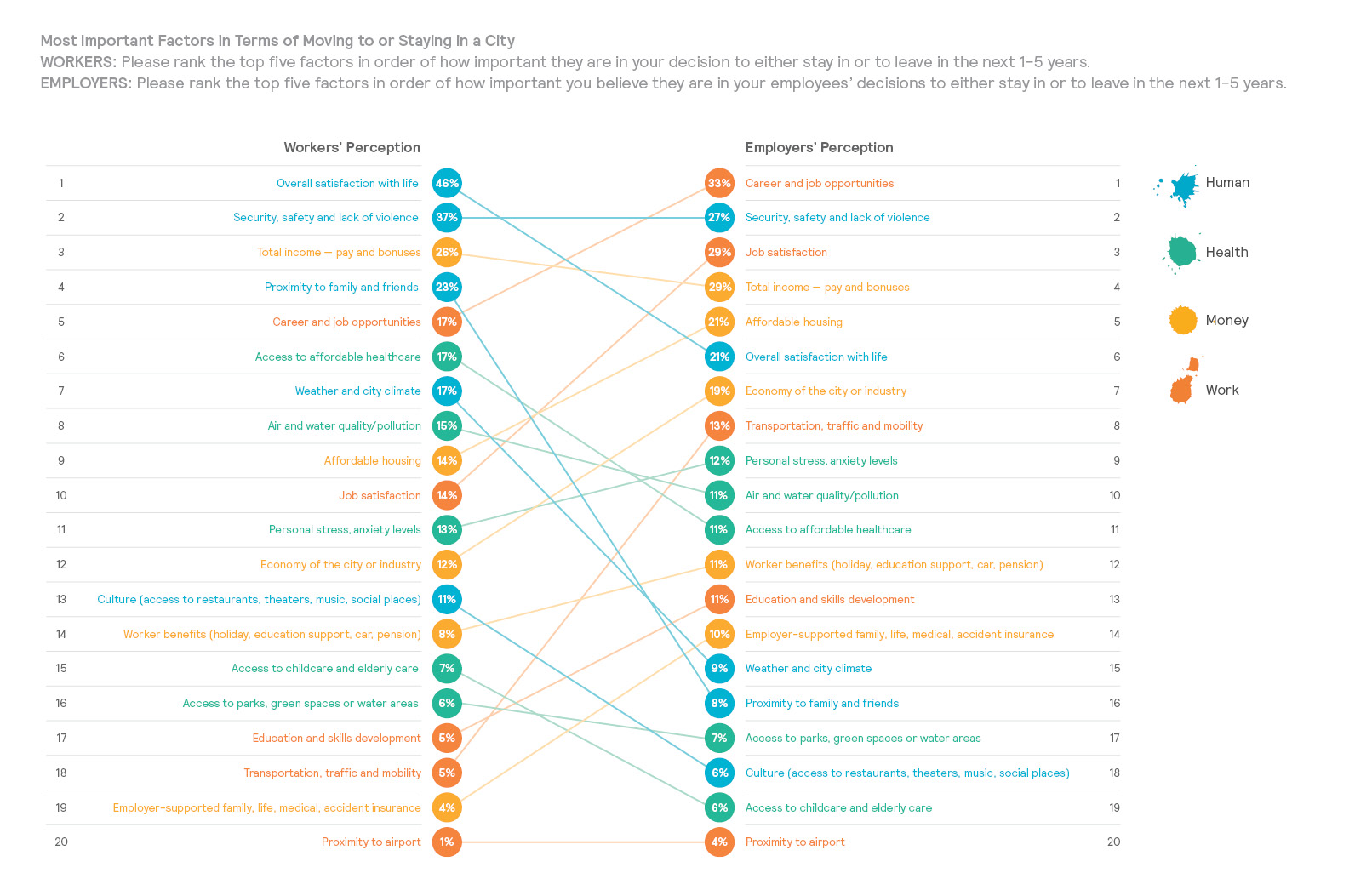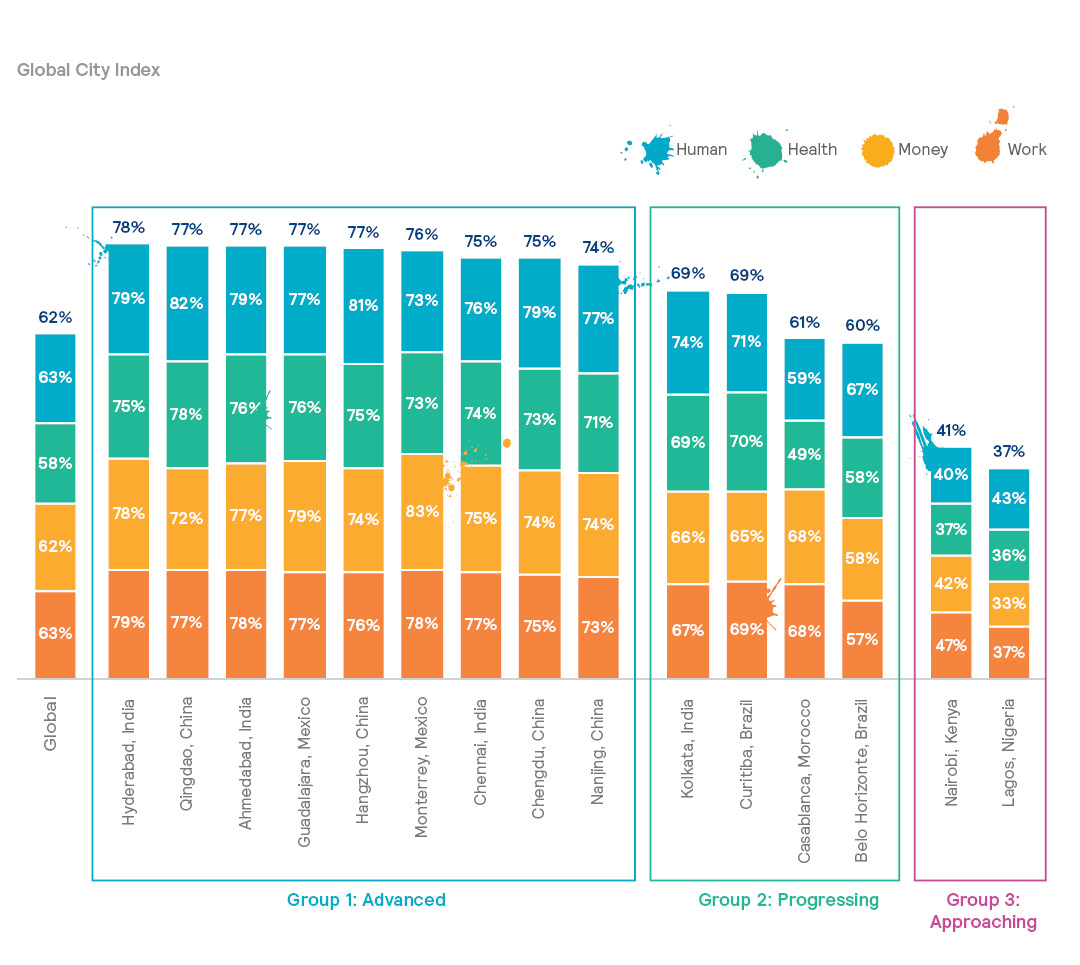“Next-generation megacities are challenging the economic power of established hubs by focusing on how forward-thinking employees define life satisfaction”
The Urbanization of the Global Population - Nearly half of the world’s GDP growth will come from about 400 cities across growth economies in the next ten years. Urbanization continues to profoundly shape the cultural and economic dynamics of modern societies, especially as today’s skilled and talented employees gravitate toward the professional, personal and cultural amenities provided by contemporary metropolitan areas. In fact, urbanization increased from 13% to 55% in the last century and is projected to grow to 70% by 2050. This growth, however, is providing overlooked urban areas with opportunities to leapfrog established megacities that were once the de facto homes to the world’s most successful employees and businesses.
A lack of highly skilled workers means that cities and companies must compete with increasing ferocity for the talented workers who will lead their businesses into the future. These highly desired employees are setting new trends in urbanization as they prioritize a confluence of human and societal factors when deciding where to work, live and raise their families. A new landmark Mercer study, People First: Driving Growth in Emerging Megacities, explores why “satisfaction with life” ranks as the most important factor to workers in 15 emerging megacities—and analyzes how safety, security and other key professional and hyper-local considerations factor into landing top talent.
The survey focuses on 7,200 workers and 577 employers across seven countries: Brazil, China, India, Kenya, Mexico, Morocco and Nigeria. The Mercer report investigates the prevailing needs of today’s workers, and the motivations and concerns that inform their decisions regarding where to work, and why. The report also analyzes the ability of employers and megacities to fulfill the needs of workers and their families. In an increasingly urbanized world where highly skilled talent is scarce, employers and cities are asking important existential questions: What makes professionals move to and stay in a particular city? How can employers and cities retain talented workers with the high-level skills demanded by rising start-ups, upcoming unicorns and global brands in emerging hot spots? What, exactly, do productive employees want from an employer and home city?
The Desire to Live Well in the Cities of Tomorrow
Mercer’s report reveals the importance of acknowledging and internalizing the priorities of people. Companies too often operate under the assumption that creating career and job opportunities (ranked #1 by employers) is key to unlocking growth potential throughout their business and host city. Businesses are also under the impression that job satisfaction (ranked #3 by employers) is another key contributor that compels cities to flourish. These misleading conclusions can be profoundly costly to businesses and megacities and undermine their ability to compete in the modern global economy.
As part of the research, Mercer conducted an employee-focused segmentation analysis based on each respondent’s demographics, life stage, career progression, predisposition to life-long learning, aspirations and levels of financial security. The report contextualizes worker’s “satisfaction with life” through four key metrics: human, health, money and work. Identifying the specific needs and values of each unique employee segment provides employers and planners in high-growth cities with valuable insights needed to attract and retain highly skilled talent.
Though career opportunities and job satisfaction are important to financial well-being, employees are placing more emphasis on the importance of family, security and environmental influences that impact emotional stress, lifestyle affordability and personal health. The chart below illustrates the remarkable discrepancies in how employers and workers perceive the various components of “satisfaction with life”:

Leapfrogging Established Power Hubs
From Shanghai to Seoul, the world is very familiar with the influence powerful megacities have on the global economy. However, the incredible success of these cities also contributes to the challenges that may limit their growth in the future. Skyrocketing rents and costs of living, unwieldy population and pollution rates, limited access to affordable family-care services and education, increasing commuting times and aging infrastructure all serve to undermine the very amenities modern employees seek when deciding where to live and raise their families. Emerging and next-generation cities, in contrast, are better situated to accommodate and grow with—not in reaction to—the needs of modern workers.
A business or megacity is only as strong as its people. To compete against established power hubs and build a formidable presence in the global economy, emerging megacities must proactively accommodate the full scope of professional, personal and cultural demands from skilled employees. Although the study’s 15 current and future megacities share some commonalities, it did reveal key differences regarding performance when addressing the human, health, money and work categories. The report classified the cities into three groups based on their abilities to fulfill worker expectations—advanced, progressing and approaching.

Theses 15 emerging megacities have a collective population of more than 113 million people, strong projected GDP, more than $4 billion of foreign direct investment annually and a population growth trajectory expected to reach one billion new consumers over the next decade. These growth economies represent the forefront of the emerging global economy. If the business leaders, government policymakers and infrastructure planners in these 15 cities align their resources and incorporate the “voice of the employee” into their decisions and planning processes, they can successfully manifest the human and social factors that drive residency decisions. With a greater understanding of the specific human needs, wants and motivations of each segment of the employee population, businesses can tailor their offerings and programs to better attract and retain the best talent—and leapfrog over established hubs, one employee at a time.
A New Era of Collaboration
Neither employers nor next-generation megacities can deliver “satisfaction with life” alone. Skilled employees demand resources that will require the combined efforts of businesses and city governments. Corporate thought leaders and policymakers must create and implement new policies and frameworks that accommodate digital transformation, globalization, modern healthcare and the educational environments valued by forward-thinking families. Empowering a new era of collaboration begins with elevating the voices and concerns of individual workers and the collective workforce. Employers and emerging megacities must appreciate how employees want to live their lives, work, earn, and learn.
Of course, not every employer or megacity is the same. The needs of workers can vary based on their surrounding communities, seasonal changes, personal situations (such a health concerns), life aspirations, and even factors like the proximity of their home to their workplace or school. Thinking beyond traditional business dynamics and prioritizing the complex needs of employees demands a fresh mindset. Stretch assignments, retention bonuses and travel allowances have a limited impact. Businesses and megacities need to create a nurturing environment for workers, where they pursue lives that offer new ways to work, support their families and connect with their communities.
Effective public-private partnerships can facilitate improvements and accelerate progress at scale. By creating environments in which workers and their families can thrive, companies and governments can create sustainable economic growth for everyone and address the future needs of the employees they are trying to attract. For example, a lack of affordable housing, regional transportation challenges, access to childcare and elderly care directly impact the life satisfaction of employees. To address the depth and scope of such elaborate challenges, employers and next-generation megacities should seek collaborations with other businesses, civil societies and support organizations to develop strategies that serve employees and their families. Those that don’t, may get left behind.
To access more insights and practical advice on how companies and municipalities can accelerate their people strategies and realize commercial gains, download People First: Driving Growth in Emerging Megacities.







